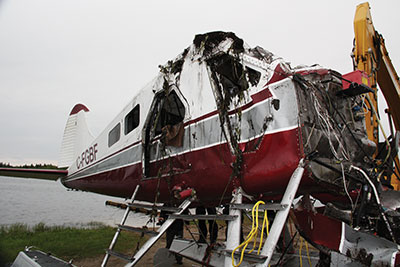
Features
Safety
Air Surveillance: Would you be able to get out?
On May 25, 2012, a commercially operated de Havilland Beaver floatplane crashed into Lillabelle Lake in northern Ontario.
January 10, 2014 By Kathy Fox
On May 25, 2012, a commercially operated de Havilland Beaver floatplane crashed into Lillabelle Lake in northern Ontario. There were three people on board. And although the initial impact was survivable, only one person made it out of the wreckage. The other two, including the pilot, were trapped upside down in the submerged floatplane and drowned.
 |
|
| In just one region, the Vancouver Harbour, there are some 33,000 floatplane movements a year, carrying roughly 300,000 passengers. Photo: Transportation Safety Board of Canada
|
Commercial seaplanes – floatplanes – operate all over Canada because they can go places other aircraft cannot. Whether they are used as air taxis to ferry wilderness travellers in and out of remote lakes or to get commuters to work every morning, they are a valuable part of Canada’s transportation network. Just how valuable are they? In one region alone, the Vancouver Harbour, there are some 33,000 floatplane movements a year, carrying roughly 300,000 passengers.
But when trouble strikes, the very thing that makes floatplanes unique also makes them vulnerable. Too many times over the past decades, the Transportation Safety Board of Canada (TSB) has investigated accidents involving floatplanes only to find the same risks appearing time and again, which can be summed up this way: If you don’t get out, you will drown; and even if you do get out, without personal flotation, you might still drown.
The numbers are shocking. According to a 1994 safety study conducted by the TSB, roughly 70 per cent of the fatalities involving aircraft that crash and are submerged in water are from drowning. The fatalities are not from the crash or from the impact, but because people are unable to get out. Or if they do get out, it’s because they’re too exhausted or injured to stay afloat.
This is why, in 2011, the TSB recommended that Transport Canada require that all new and existing commercial seaplanes be fitted with regular and emergency exits that allow rapid egress following a survivable collision with water, and that personal flotation devices be worn by all occupants. Then, at the conclusion of the recent Lillabelle Lake investigation, the TSB went even further and recommended that all commercial floatplane crews be required to take underwater egress training. Here’s why. In an emergency, you have only seconds to orient yourself and get out of that aircraft. Underwater egress training can make a real difference, and pilots who have this training stand a better chance of getting out of a submerged plane. In fact, following the TSB’s investigation into a 2009 Beaver accident in Lyall Harbour, B.C., in which the pilot and one passenger survived while six other passengers drowned, the TSB’s final report stated, “It is likely that the pilot’s recent egress training contributed to him being able to open the door and escape from the aircraft.”
As a member of the TSB since 2007, I have reviewed many accident investigation reports over the years. I have also travelled a number of times on commercial floatplanes, and, as a pilot, I regularly take off and land over water at my home airport. In 2002, I decided to confront my own fears about being trapped in a submerged aircraft by taking underwater egress training.
The one-day course cost a few hundred dollars – roughly the equivalent of two to three hours of rental flying at my local flying club. First, there was a classroom session covering the basics of flotation devices and other water survival equipment, as well as practical egress techniques.
I maintain that learning (and practising) how to remain calm, retrieve (or preferably wear) a suitable PFD and take the right steps to locate the nearest usable exit prior to releasing the seatbelt, significantly enhances my chances of survival if the unthinkable happens. As a pilot and a member of an organization dedicated to advancing safety, that’s a recommendation I can endorse – both personally and professionally.
Kathy Fox has been a member of the TSB since 2007. The TSB is an independent agency that investigates marine, pipeline, railway and aviation transportation occurrences.